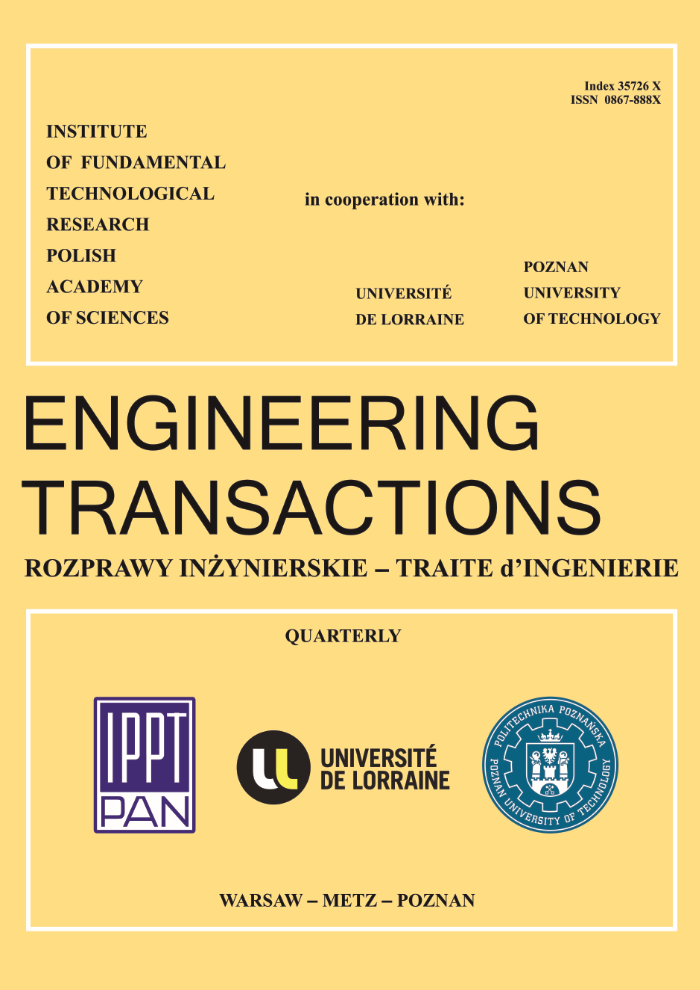Abstract
Solving a creep crack growth problem using the CAFE methodology encounters the problems typical of other local methods. This article presents a nonlocal grid method applied in order to regularize these problems. The subject of the analysis is a rectangular plate with a central hole and an internal crack. The results obtained for different mesh sizes have subsequently been compared.Keywords:
nonlocal method, grid method, CAFE, creep damageReferences
[[1] Bodnar A., Chrzanowski M., Nowak K., Brittle failure lines in creeping plates, International Journal of Pressure Vessels and Piping, 66(1–3): 253–261, 1996.
[2] Murakami S., Liu Y., Mesh–dependence in local approach to creep fracture, International Journal of Damage Mechanics, 4(3): 230–250, 1995.
[3] Hayhurst D.R., Brown P.R., Morrison C.J., The role of continuum damage in creep crack growth, Philosophical Transactions of the Royal Society of London. Series A: Mathematical and Physical, 311(1516): 131–158, 1984, https://doi.org/10.1098/rsta.1984.0022.
[4] Murakami S., Continuum damage mechanics: a continuum mechanics approach to the analysis of damage and fracture, Springer, Dordrecht–Heidelberg–London–New York, 2012.
[5] Besson J., Continuum models of ductile fracture: a review, International Journal of Damage Mechanics, 19(1): 3–52, 2010.
[6] Hall F.R., Hayhurst D.R., Modelling of grain size effects in creep crack growth using a non-local continuum damage approach, Proceedings of the Royal Society A: Mathematical, Physical & Engineering Sciences , 433(1888): 405–421, 1991.
[7] Bilby B.A., Howard I.C., Li Z.H., Mesh independent cell models for continuum damage theory, Fatigue and Fracture of Engineering Materials and Structures, 17(1888): 1221–1233, 1994.
[8] de Vree J.H.P., Brekelmans W.A.M., van Gils M.A.J., Comparison of nonlocal approaches in continuum damage mechanics, Computers & Structures, 55(4): 581–588, 1995.
[9] Nowak K., Cellular automata multiscale model of creep deformation and damage, in: Deterioration and failure of structural materials, J. German [ed.], CUT Press, Kraków, 65–84, 2014.
[10] Shterenlikht A., Howard I.C., The CAFE model of fracture – application to a TMCR steel, Fatigue and Fracture of Engineering Materials and Structures, 29: 770–787, 2006.
[11] Madej Ł., Hodgson P.D., Pietrzyk M., The validation of a multiscale rheological model of discontinuous phenomena during metal rolling, Computational Materials Science, 41(2): 236–241, 2007.
[12] Chrzanowski M., On the possibility of describing the complete process of metallic creep, Bull. Ac. Pol. Sc. Ser. Sc. Techn., XX: 75–81, 1972.
[13] Belloni G., Bernasconi G., Piatti G., Creep damage and rupture in AISI 310 austenitic steel, Meccanica; 12(2): 84–96, 1977.
[2] Murakami S., Liu Y., Mesh–dependence in local approach to creep fracture, International Journal of Damage Mechanics, 4(3): 230–250, 1995.
[3] Hayhurst D.R., Brown P.R., Morrison C.J., The role of continuum damage in creep crack growth, Philosophical Transactions of the Royal Society of London. Series A: Mathematical and Physical, 311(1516): 131–158, 1984, https://doi.org/10.1098/rsta.1984.0022.
[4] Murakami S., Continuum damage mechanics: a continuum mechanics approach to the analysis of damage and fracture, Springer, Dordrecht–Heidelberg–London–New York, 2012.
[5] Besson J., Continuum models of ductile fracture: a review, International Journal of Damage Mechanics, 19(1): 3–52, 2010.
[6] Hall F.R., Hayhurst D.R., Modelling of grain size effects in creep crack growth using a non-local continuum damage approach, Proceedings of the Royal Society A: Mathematical, Physical & Engineering Sciences , 433(1888): 405–421, 1991.
[7] Bilby B.A., Howard I.C., Li Z.H., Mesh independent cell models for continuum damage theory, Fatigue and Fracture of Engineering Materials and Structures, 17(1888): 1221–1233, 1994.
[8] de Vree J.H.P., Brekelmans W.A.M., van Gils M.A.J., Comparison of nonlocal approaches in continuum damage mechanics, Computers & Structures, 55(4): 581–588, 1995.
[9] Nowak K., Cellular automata multiscale model of creep deformation and damage, in: Deterioration and failure of structural materials, J. German [ed.], CUT Press, Kraków, 65–84, 2014.
[10] Shterenlikht A., Howard I.C., The CAFE model of fracture – application to a TMCR steel, Fatigue and Fracture of Engineering Materials and Structures, 29: 770–787, 2006.
[11] Madej Ł., Hodgson P.D., Pietrzyk M., The validation of a multiscale rheological model of discontinuous phenomena during metal rolling, Computational Materials Science, 41(2): 236–241, 2007.
[12] Chrzanowski M., On the possibility of describing the complete process of metallic creep, Bull. Ac. Pol. Sc. Ser. Sc. Techn., XX: 75–81, 1972.
[13] Belloni G., Bernasconi G., Piatti G., Creep damage and rupture in AISI 310 austenitic steel, Meccanica; 12(2): 84–96, 1977.






